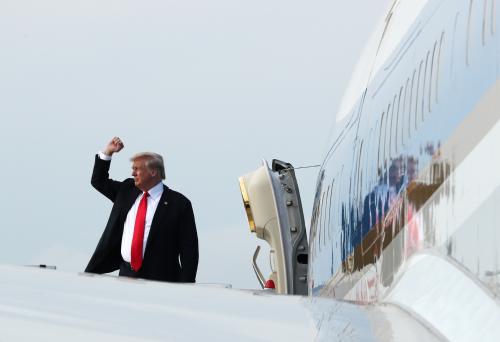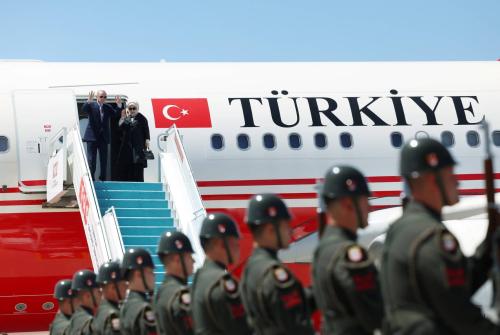Rather than allowing a future NATO summit to become just another episode of the Trump show, NATO may be better served by leaving the work to the foreign and defense ministers, who already each meet three times a year, argue Derek Chollet and Amanda Sloat. This piece originally appeared on ForeignPolicy.com.
After watching this NATO summit unfold here in Brussels, we think it’s worth considering whether this should be the last one for a while.
That’s not because the substance was disappointing. Far from it. As numerous European ministers and NATO Secretary-General Jens Stoltenberg stressed, the policy decisions formalized here were as impressive as any summit in recent memory. The United States and its European allies agreed to improve their military capabilities, do more in Iraq and across Europe’s southern border, and augment NATO’s ability to make decisions in a crisis. They invited a new member to join. They also reaffirmed their common stance against Russia and commitment to collective self-defense.
If the summit ended there, leaders would have plenty to be happy about. Indeed, they clearly learned the lessons of last month’s G-7 meeting by issuing the communique after the first day of meetings rather than waiting for its agreements to be relitigated after they were wheels up from Brussels.
But it is impossible to ignore that leaders—as well as the hundreds of NATO wonks and journalists gathered on the summit’s margins—spent two days engulfed in an unnecessary drama created, scripted, and produced by the U.S. president. While ministers and experts tried to keep the focus on the summit’s impressive deliverables, all anyone wanted to talk about was Donald Trump. He had everyone exactly where he wanted them: glued to their Twitter accounts.
This summit could have been a victory lap for the alliance. Instead, Trump’s antics—from his opening diatribe against Germany to his Thursday morning outburst about defense spending that sent leaders into a rare emergency session—left some allies asking whether the United States was on the verge of withdrawing from NATO.
We’ve sat through our fair share of NATO meetings, and these summits serve two purposes: to be action-forcing events to make decisions and to gather leaders as a visible symbol of unity and resolve. So, after spending two days watching leaders being whipsawed by Trump, we wonder whether NATO’s goals would be better served by removing a platform for the president to stage his own reality TV show.
Allies tried to manage the U.S. president with a combination of flattery and pushback. Yet they have clearly concluded they can’t appease or control him. His cheap shots, such as claiming that Germany is a “captive” of Russia; boasts, including asserting that it was the best summit ever with “a great collegial spirit”; and demands, particularly that allies spend 4 percent of GDP on defense when they are having a hard time spending 2 percent, were greeted with disbelief and eye-rolling.
Yet it would be wrong to simply ignore his rhetoric, as some are suggesting. It is having an increasingly corrosive impact on the trust that underpins this alliance. Moreover, his rants aren’t even effective. Any government inclined to increase its defense spending will find it hard to explain difficult decisions to skeptical publics in the wake of U.S. bullying. His repeated threats also raise concerns he will follow through on penalizing deadbeat allies or choosing to go it alone. We heard a lot more about how allies are preparing to work around Trump rather than to cooperate with him.
A meeting intended to be a celebration to convey unity and progress instead projected chaos and distraction. The main beneficiary is Russian President Vladimir Putin, whom Trump will see in Helsinki on Monday in what he has predicted will be the “easiest” meeting of this trip. Given that Putin will echo many of Trump’s criticisms of NATO—especially that the United States spends too much money protecting Europeans—he’s surely right.
So rather than allowing a future summit to become just another episode of the Trump show—which, like all reality shows, will have to resort to even more outrageous stunts and ridiculous plot twists to keep viewers tuned in—NATO may be better served by leaving the work to the foreign and defense ministers, who already each meet three times a year. After all, they were the ones who did all the hard work, anyway. And scaling back summitry would not be unprecedented. Prior to 1974, NATO summits were rare—up until then, the alliance had only held one since its founding in 1949. Because there’s a real danger future summits with Trump would do more harm than good, it seems prudent to reconsider the wisdom of annual leader meetings.
By all accounts, U.S. diplomats worked hard before the meeting to ensure a positive result, doing their best to keep the president’s disruptive urges in check. But U.S. bureaucrats, like European leaders, have concluded they can’t control Trump. So why try? If no one seriously thinks future NATO summits would go any better as long as he’s in office, why run the risk of having one?
The Brookings Institution is committed to quality, independence, and impact.
We are supported by a diverse array of funders. In line with our values and policies, each Brookings publication represents the sole views of its author(s).











Commentary
Should NATO even hold summits under Trump?
July 13, 2018